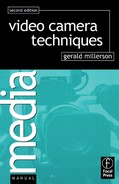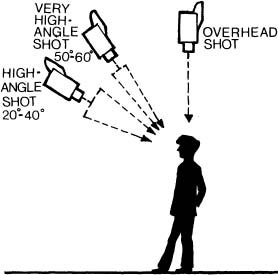A high-angle shot has the very practical advantage that it allows the camera to see over things that would otherwise obstruct the picture. However, high viewpoints can present unflattering weak shots of people. You can never get a strong, powerful shot of a person from a high camera position.
When shooting within a crowd, holding a lightweight camera above your head with arms outstretched may get by in an emergency, but it is not a recommended technique. The strain is considerable, and shots will inevitably be shaky. It is far better to climb up to a higher vantage point, and hold the camera properly.
A high tripod or pedestal will support a camera firmly up to a height of around 1.5 – 2 m (5 – 6 ft). But the controls of most cameras are not easy to operate at maximum elevation. In addition, you may be unable to see into the viewfinder screen properly. It will often help if you stand on a pedestal’s base, or on a box (riser, block).
It is unrealistic to expect a single operator to move the pedestal around at maximum height while on shot with any sort of accuracy. If the camera needs to dolly (track), truck (crab) or arc, then a second person is needed to push and guide it. But it’s an unreliable process.
Even if your viewfinder is well shielded from stray light and tilted down, you may still find yourself looking up towards a bright sky or into studio lights. That will make it much more difficult to follow focusing accurately.
There is a world of difference between operating an extendable jib arm mounted on a tripod or pedestal, and a camera crane. Remotely controlling the jib camera while watching a monitor is a ‘detached’ process, compared with the more integrated feeling when sitting on a crane. Although the jib camera can swing round an arc of 360°, and change height from e.g. 0.3 – 3 m (1 – 10 ft), a director would be unwise to expect the camera to focus, pan, tilt, zoom, boom up and move around at the same time! When working at full height, there is always the hazard of the camera colliding with overhanging lights, scenery, cables.
As the camera rises, it sees more and more of the floor. Because we are accustomed to seeing a foreshortened view of space (like a camera at eye level), the floor area looks disproportionally large and less impressive on high shots; particularly when using a wide lens angle. A high close camera is very likely to shadow a subject.
Terms
High-angle shots tend to reduce the strength of a subject but give a clearer view of the action. They may be shot from an elevated camera or via a slung mirror or from a raised vantage point – e.g. a platform or tower.

The effects of height changes
As the camera moves to a higher viewpoint, the floor becomes more prominent and the audience often feels less involved in the action.

